5 key facts about this project
The design of the Structure Tower features a triangular lattice configuration that not only enhances its aesthetic appeal but also contributes to structural integrity. By minimizing the amount of material used, the architecture becomes lighter and more efficient without compromising stability. This approach to design demonstrates a commitment to reducing resource consumption while still achieving an impressive vertical presence in the city skyline.
One of the defining characteristics of the Structure Tower is its adaptable nature. The building is segmented into modular sections that can be reconfigured as needed. This flexibility allows for a variety of uses, such as office spaces, retail environments, and residential units. Such adaptability is an increasingly important feature in contemporary architecture, aligning with the evolving needs of urban populations and the dynamics of city life.
The materials selected for the Structure Tower further illustrate the project's thoughtful approach to architecture. The use of stainless steel for the frames and joints not only provides durability but also presents a contemporary aesthetic that complements the glass panels cladding the exterior. The glass allows for ample natural light to penetrate the interiors, creating inviting work and living spaces while also maintaining energy efficiency. These materials are purposefully chosen to enhance both the visual impact of the building and its functional capabilities.
The innovative design strategies employed in the Structure Tower also include unique structural connections through ball joint mechanisms that allow for flexibility and ease of construction. These connections facilitate the building's dynamic response to environmental factors while ensuring safety and durability. The architectural design embraces not just robustness but also interaction with its surroundings, making it a landmark that resonates with the urban environment.
In terms of circulation, the Structure Tower incorporates efficient vertical transportation systems with strategically placed elevators and stairways that enable easy movement throughout the building. This design not only improves accessibility but also enhances the user experience, promoting a seamless flow between the different functional areas. The architecture encourages social interaction by providing shared spaces and communal areas that foster community engagement among occupants.
The Structure Tower is more than just a high-rise; it is a response to the urban challenges of our time. It embodies a thoughtful dialogue between form and function, where each element serves a specific purpose while contributing to an overall vision of sustainability and adaptability. The architectural design emphasizes the importance of ecological concerns in the face of rapid urbanization, presenting a model that future developments may emulate.
For readers intrigued by this architectural project, further exploration is encouraged. Examining the architectural plans, sections, and designs can provide deeper insights into the thoughtful ideas that shaped the Structure Tower. This project stands as a testament to how modern architecture can embrace both innovation and traditional principles, creating spaces that not only serve present needs but are also considerate of the future.























